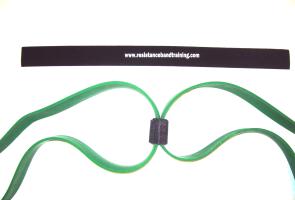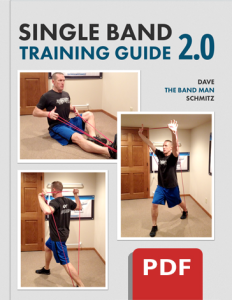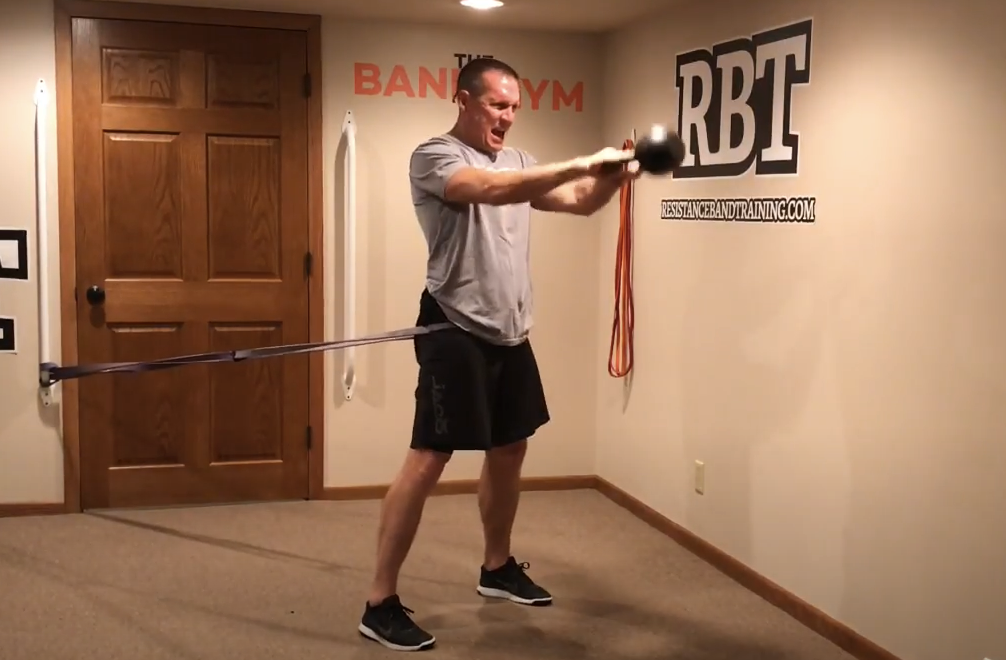Reasons for Band Breakage
Yes, a band can break, especially if it’s a less durable, molded flat or tubular band. That’s why you see more elastic devices being covered with nylon to keep the band encased when it breaks. The problem is nylon covered bands create a solid end point that can lead to jarring or traction type joint injuries if that end point is accidentally exceeded during training—which frequently happens.
99% of why bands break comes down to choosing the correct resistance level and teaching your client and athletes proper band training techniques.
Let me share with you reasons why bands break and how you can eliminate 99% of these issues without training using a nylon covered band.
1. Poor attachment points
Where you attach your bands will determine how long they last. Many individuals irresponsibly attach bands to objects that have corners or edges that will cut into the band and ultimately weaken or tear it. Completely rounded surfaces must be used to attach bands which is why we strongly recommend using THE BAR.
2. Not setting visual training parameters
When individuals train, they should not have to worry about determining the distance they train on every repetition. By setting a visual parameter, it instinctively teaches a client how far they should stretch the band and eliminate accidental overstretching of the band while still allowing for uninhibited training.
3. Not willing to stop and change band strength level
Convenience tears bands more often than it should. Individuals that do not understand band stretch tolerance will over stretch the band to get more resistance instead of taking the time to choose a higher resistance level band.
They can’t do this with a dumbbell but they will with a band. This can be eliminated through proper training, education and understanding the importance of having multiple band resistance levels available to train with.
4. Poor monitoring of a training session
Large boot camps are great for RBT but only if coaches can monitor how people are training with bands. Proper education and reinforcement of that education with proper verbal cuing will quickly teach clients how to police themselves when it comes to training with bands.
5. Not teaching individuals how to position themselves correctly with partner attached training
If you enjoy doing partner attached training, great. Make sure you learn proper holding techniques first.
Take note, having the holding person facing the training person while holding the bands in their hands is unsafe. Unfortunately, this type of hold is often used because it is easy and convenient to do. However, this type of hold increases the risk of injury for both the holder and training partner.
Learn How to Safely Implement Partner Band Training
6. Not respecting the importance of teaching your client about bands
Bands are not provided the training respect they deserve when it comes to getting results. Concurrently, when it comes to teaching proper band training techniques, people do not approach the learning and teaching process with the respect bands deserve thus leaving training to occur using a “trial and error” approach which ultimately leads to bands being prematurely damaged.
7. Not educating yourself on band quality
There are cheap flat bands and tubes and there are high quality flat bands like the Quantum Band. Unfortunately, you get what you pay for. Cheaper quality bands and tubes break when following many of the more aggressive RBT.com training approaches. In order to perform quality and effective resistance band training you must use a high quality band which the Quantum Band is for a variety of reasons.
Quantum Band Difference
8. Not Un-linking bands
Instead of using link straps, many people save the $4 and link the bands directly together. This may be ok unless the bands are not taken apart after a training session. If not taken a part, the added tension will weaken the bands and ultimately tear them if repeated use occurs without the bands being taken apart.
9. Poor band maintenance
Letting wet bands stay wet or allowing bands to lie in the hot sun or freezing cold for long periods of time will begin to prematurely break down the latex and weaken the band. Making sure bands dry out properly and are stored in appropriate temperatures will result in bands lasting a long time.
10. Treating bands like they are a dumbbell
Bands are not made of iron and therefore cannot be treated like they are. Flat continuously looped layered Quantum Bands are extremely durable when compared to other elastic resistance base tools.
However, the issue occurs when individuals attempt to treat them like a dumbbell or barbell by over stretching them or carelessly attaching them to structures that can cut them. These are issues that are not a concern with free weights but it is also why resistance bands are more versatile than a free weight when it comes to training.
11. Grinding bands into the floor surface
Attachment Free Band Training is awesome and will not damage your bands unless you choose to grind a band that is positioned around your feet into an abrasive surface repeatedly. This is a common mistake that will tether a band and weaken it to the point where it will break.
12. Linking two different size bands together
Bands have different levels of tension strength. Training with two different strength level bands linked together will result in the lower resistant band being over stretched and potentially torn.
13. Using one band to train everything
Different movements require greater levels of resistance to challenge the muscles effectively. A band’s ascending resistance provides the benefits of a 30lb to 40lb resistance variability but “one size fits all” is not one of those benefits and therefore having 2 or 3 levels of band strength is recommended.
Summary
The best way to ensure you have the right bands to do the right job, is to make sure you have multiple band levels. Along with that, take the time as a coach or trainer to teach your clients how to train safely with bands.









